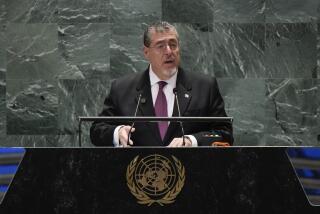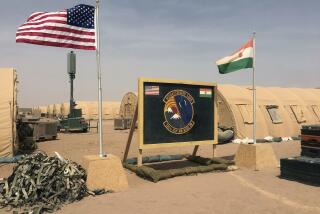Last of U.S. Troops Leave Grenada : 30 Americans Stay to Train Caribbean Nation’s Police
- Share via
ST. GEORGE'S, Grenada — American military intervention in Grenada officially ended Tuesday when two transport planes, carrying 66 U.S. soldiers, took off in the morning rain and roared away over the gray Caribbean Sea.
The departure left Grenada without American security forces for the first time since the U.S.-led invasion of the tiny Eastern Caribbean island nation and the dissolution of its strife-ridden leftist government in October, 1983.
A 250-member U.S. Army contingent stayed on after the invasion to help patrol the nation of 90,000 people while Grenadian security forces were being reorganized and trained. Tuesday’s departure leaves only 30 U.S. Army Special Forces soldiers, who will remain until late September to give paramilitary training to Grenadian police.
About 100 military policemen from Jamaica and Barbados, the remainder of a 400-member Caribbean peacekeeping force that joined U.S. troops in patrolling Grenada after the invasion, are also preparing to leave.
Withdrawal of the American military police began two months ago and ended Tuesday with a brief ceremony at Grenada’s new Point Salines International Airport. The troops boarded C-141 and C-130 transports and headed for their bases, Ft. Dix, N.J., and Ft. Bragg, N.C.
Prime Minister Herbert Blaize, 67, attended Tuesday’s airport ceremony but, because of the rain, did not get out of his auto, which was parked on the tarmac. As the American soldiers stood at attention in the downpour, the frail prime minister rolled down his window to hear the playing of the U.S. and Grenadian national anthems.
Air Force Col. Wayne Topp, deputy commander of U.S. forces in the Caribbean, flew in on a T-39 jet from Florida to be on hand for the final departure. He expressed pride in what the Reagan Administration calls the “rescue operation” of American medical students trapped on the island and its aftermath.
‘Banner Day’
“I think this is a banner day,” Topp told reporters at the airport. “It is not too often that the United States comes in to do something and leaves kind of clean. We tend not to do that.”
Roy Haverkamp, charge d’affaires of the U.S. Embassy here, said, “We want to go when the going is good, when we are still loved and wanted.”
The overwhelming majority of Grenadians appeared to support the invasion. It led to parliamentary elections last December in which Blaize’s moderate New National Party won 14 of the 15 seats.
In the campaign, Blaize had firmly endorsed the U.S. intervention and the American Embassy here had made no secret of its favor for his party.
Former Prime Minister Eric Gairy, Blaize’s main political rival, has also applauded the “rescue mission.” A few days ago, Gairy visited the U.S. Embassy to deliver a petition with 22,000 signatures asking President Reagan to reconsider the withdrawal of the remaining American military police.
Warnings of Leftists
Gairy predicted in an interview that, with the American troops gone, Grenadian Marxists will “make an attempt to disrupt the peace and destabilize the country.”
In an interview, Blaize did not rule out that possibility. “Troublemakers are always looking for opportunities to make trouble,” he said, adding, “If they make trouble, we’ll be ready to deal with them.”
Blaize said that many Grenadians are worried by the departure of the American military police.
“The Americans are a symbol of security and, to some people, the symbol is more important than the fact,” he said. “The fact that the Americans are leaving does not mean that we are being abandoned.”
British advisers have helped with the reorganization and training of the Grenadian police force, which soon will have 540 members. About eighty of the Grenadian policemen have also received paramilitary training from the 30 Special Forces instructors.
Special Services Unit
The Grenadian paramilitary force, called the Special Services Unit, is made up of two 40-man platoons. One of the platoons will be “active,” equipped with automatic rifles, machine guns, grenade-launchers and other military equipment; the other is to be kept in reserve while its members carry out regular police duties.
The Grenadian Special Services Unit is one of five such organizations trained by the United States in small island nations of the Eastern Caribbean. The countries are preparing to sign a treaty with Barbados--a larger country with a full-fledged military defense force--that will provide for military cooperation in case of an emergency on any of the islands.
The treaty will also permit the United States to sign an agreement for military training and cooperation with the islands as a group, a U.S. Embassy spokesman said.
Plans currently are being made for military exercises in September that will include the five Special Services Units and American troops. The exercises, as well as frequent visits by U.S. Coast Guard and Navy ships, are intended to demonstrate continued U.S. security interest in the Eastern Caribbean.
The 371-foot Navy frigate McCloy tied up Sunday in St. George’s Harbor. The warship, which came here from its base in Norfolk, Va., is scheduled to return there this week.
Previous Turmoil
The political peace that has settled in Grenada after the invasion contrasts sharply to the turmoil that reigned in previous years.
After Gairy led Grenada to full independence from Britain in 1974, unrest grew as his government became increasingly repressive. The revolutionary New Jewel Movement overthrew Gairy’s government in a bloodless coup in March, 1979, installing Maurice Bishop as prime minister.
Bishop’s government was also repressive. It created a military force called the People’s Revolutionary Army and built it to an estimated strength of 2,000 men. It also invited Cuban advisers who, among other things, began to build the Point Salines airport.
Given the Marxist leanings of Bishop’s government, the airport’s long, jet-capable runways were deemed by the Reagan Administration as a threat to hemispheric security.
Leftist Split
Bishop’s rivals in the New Jewel Movement put him under house arrest on Oct. 12, 1983, and violence broke out in St. George’s on Oct. 19, after a crowd of Bishop’s supporters freed him. More than 100 people are believed to have been killed in a clash between the crowd and the army. Bishop was executed.
The U.S. invasion, requested by leaders of other Eastern Caribbean countries, began on the morning of Oct. 25, 1983. Marines, Army Rangers and troops of the 82nd Airborne--an invasion force of 1,900 men--took the island by storm.
U.S. military forces on Grenada quickly swelled to more than 6,000 people. Resistance by the People’s Revolutionary Army of Grenada and by Cuban workers and soldiers was disorganized and short-lived.
Forty-four Grenadians were killed, as were, according to Havana, 27 Cubans. The Pentagon has said 20 American servicemen were killed, more than half in accidents.
By mid-December, the invasion force had pulled out, leaving behind only the military police and the instructors.
More to Read
Sign up for Essential California
The most important California stories and recommendations in your inbox every morning.
You may occasionally receive promotional content from the Los Angeles Times.













